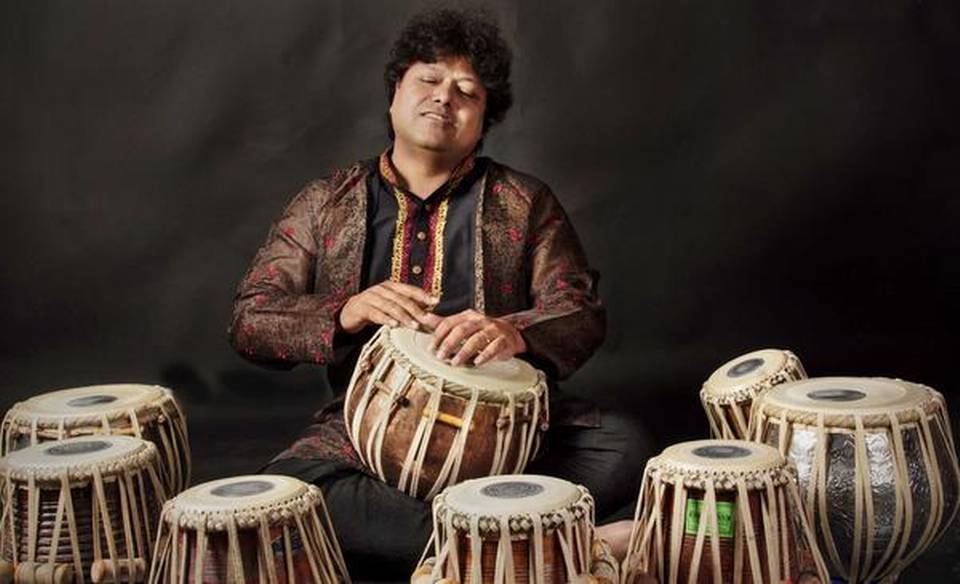In a candid conversation, tabla wizard Pandit Subhankar Banerjee talks about creating unique aural and rhythmic designs
A man of few words, apparently almost withdrawn and shy at 51, Pt. Subhankar Banerjee’s multifarious, imposing, tall-dark-handsome personality communicates gently but firmly through his works in the spheres of music and self-imposed commitments towards the physically challenged; with tabla as his mouthpiece, both, as a solo instrument and as an accompanying appliance which can transpose any musical instrument’s rhythmic innovations, however complex, into its own language! This one-to-one on-stage dialogue with legendary musicians has earned him an enviable place among the stars of his generation.
And yet he is down to earth – a devout family man, tied in the bonds of boundless love for his mother (the late singer-composer Kajalrekha), for all his gurus who nurtured his innate talent, for his vocalist wife Nivedita, who became the family’s support system ever since his mother’s untimely death in 1998, for his two extremely talented children Aahiri and Aarchik, who are shaping up as fine vocalist and tabla exponent respectively, for his numerous disciples who look up to him and do him proud, and for Taalsen, the temple of music, that took shape slowly under his dedicated care.
The first annual event of Taalsen Music Academy at Kolkata’s Gandhi Memorial Hall, organised by the Kajalrekha Musical Foundation, featured these budding musicians, recently. One could gauge the honest hard work that went behind the show. Usually the fountainhead of love dries up under the glare of hectic professional commitments and schedules. How does he manage to be so committed and cool as a sought after musician, composer, guru, spouse and father!
Banerjee’s answer is plain, “I follow the footprints of my mother in every walk of life. Ma was afflicted by polio at three, and yet glowed with inner strength springing out of sheer positivity and immeasurable love. Till her last she would say, “I am unique, so are you; when I am there, why worry!” And she did take care of everything. She had trained in different genres of music with several pundits. My father, a government employee, loved tabla passionately; it was music that united my parents. By the time I began to comprehend music, ma was still quite young and very active in the arena of music.”
Immaculate grooming
He always saw hoards of musicians, composers, lyricists at home; listened to creators of music who discussed different modes of compositions and methods of complimenting accompaniment. “I saw both the streams, classical and commercial, from very close quarters. The art of adding sheen to a three minute song with different bols of tabla always amazed me. I have sharp, enormous memory. Ma would call me ‘tape recorder’ and yes, all that is still etched on my mind.”
Despite her handicap, despite her busy schedule as a musician-composer-teacher, despite her responsibilities as a homemaker, Kajalrekha raised him with loving care and trained him in classical (vocal) music along with the academics. “I completed Sangeet Visharad by the time I was 15 and graduated with English (Honours). In college I was popular as a singer. I have cut discs too. Even now I swap roles with Rashid (Khan) bhai or Ajoy (Chakrabarty) da. They play the tabla, and I sing!”
But tabla had been his first love. “Ami bajaate bhaalobashi. Once Swapan (Chaudhuri) da recited something and asked me to play. Hat chalto, and I played. Noticing my love for tabla, our neighbour Manik Das, a disciple of Pandit Samta Prasad, introduced me to Benares baaj. Guruji (Swapan Shib) and several other tabla maestros belonging to different gharanas would come to our house. I heard Samta Prasadji live on stage with father. His dha was like tanpura. I always strive to play like that. Keramatulla Khansaheb was nicknamed as ‘Marammat Khan’- such was the contribution of his accompaniment! All left an indelible mark on my sensibilities.”
Career curves
By the time he was 16, he started earning, thanks to commercial music. “I played lots of recordings; accompanied Lata-kanthi, Manna-kanthi, played with eminent artistes like Arati Mukherjee, Shriradha Banerjee; I enjoyed playing with singers belonging to different genres. It was always a challenge to take a song from a certain level to a much higher plane with the help of perceptive tabla.” This exposure to commercial music posed no problem in his entry to classical music because since childhood he saw and knew that one compliments the other, both technically and aesthetically. “The so-called light beginning gave me a clear insight of numerous shades of bols to compliment different touch (sparsha) notes of music-making.”
Around this time, Pandit Salil Shankar, a close associate of Pandit Ravi Shankar, took him on a nine-month tour abroad. “This was my major break in classical arena; and his ruthlessly frank criticism, that too during live stage concerts, hurt me; but compelled to see the finer nuances that play a very major role in defining a particular cadence created by ‘minor’ but important stress-points. For example, once he was playing Gara-dhun, set to double dadra. Both of us were not happy with the effect of the theka. He asked, have you ever seen Gujarati Garba dance with huge dhols? Imagine that and play something in that fashion. And it worked like magic! Later I found that this kind of theka was played by Allarakha sahib.”
Technique of accompaniment
Banerjee holds, usually accompaniment is not taught. “Experience teaches. This experience taught me a lot! To understand the subject better, I began listening to records. In Berne, I was introduced to a fantastic collector of records whom we all refer to as the ‘Swiss Bank of tabla’. He would guide me to ‘Habibuddin in 1954’, ‘Thirakwasahab in 1957’ or Wazir Hussain Khan’s radio programme in 1961 and ‘a few of his stage recitals during that time period.’ For almost a decade, I heard them and all that is stuffed inside me from head to toe.”
He says, within his limited capability, he also tries to study the style of the vocalists, instrumentalists and dancers. “Now I know that Raga Darbari is not like Khamaj (and commands different treatment). Moreover, the same raga changes its mood during each presentation; and with every changing mood its art of accompaniment should change. Depending on the demand of the artiste, the raga, the gharana and the mood of the bandish, a ‘terekete’ must radiate different hues. The mix of tabla and bayan, their volume control, the making of the ‘zamin’ (groundwork) of the layakari or theka’s chaal (gait) and lachak (swaying moves) depends on the raga’s character and also the persona of the artiste.”
He knows that he needs to win “the faith of the music-maker by providing a blank canvas first and then help him colour it with the desired lilt.” “What can go with Rashid, cannot apply in the case of Venkatesh Kumarji. Budhaditya da, Shujaat bhai, Nishaat bhai, Shahid ji – all belong to one gharana; but their requirements differ vastly.”
Going solo
Initially, he says, he used to copy the greats. “Zakir sahab, Kumar (Bose) da , Anindo (Chatterjee) da – ditto. It continued till 1991-92; later I started thinking, began composing, and playing my own stuff but not beyond the gharana. Zakir sahab acknowledged this and said, ‘His playing style has his own pehchan.’ This is a huge blessing. I focus on the first dha which will compel you to listen to the tabla! Technical treatment changes the tone of a particular bol. The same mnemonic appears differently after five years! With my mental maturity the coloration of the bol matures. I believe in telling a story by creating varied aural and rhythmic designs.”
Cherished moments
As a youngster he never thought that he will play with legends like Pandit Ravi Shankar or Ali Akbar Khan. “By God’s grace I have witnessed many memorable concerts by masters such as Ali Akbar Khan, Amjad Ali Khan (when he played full length raga), Shivji, Hariji; even Tejen (dra Narayan Majumdar) and Rashid. An intuitive, bindaas singer, Rashid often muttered, ‘Khak gaana hua’; but he simply did not know what he did to listeners!”
He recalls some tricky moments as well. “There are instances that nothing worked and we just managed. At times they felt challenged by my tabla. Once Hariji was running high fever during a duet with MS Gopalakrishnan; on other occasion (Birju)Maharajji had knee-joint pain and yet they gave their best. With Shivji, I had a strange experience when he played raga Shantishree, set to Rupak, to pay tribute to Pandit Bhimsen Joshiji. Such was its effect that even the quiet and softest bols on the tabla seemed to disturb the peaceful moos. The intrinsic pathos of rupak added to this effect and I did not feel like intruding at all.”
Till date, he never had an off mood. “Amar bajate bhalo lage. I always try to add a different colour and that keeps me occupied. It often recharges the other artiste on stage. I keep telling myself, ‘Tumi dekhe nio ami-e bajabo (Watch out, I Will play)! Off stage, I sing all the time, or remain preoccupied with self-composed rhythmic compositions, mostly tihais, which are considered ‘trendy’ amongst youngsters now.”
content courtesy : https://www.thehindu.com/todays-paper/tp-features/tp-fridayreview/i-believe-in-telling-a-story/article24712900.ece


